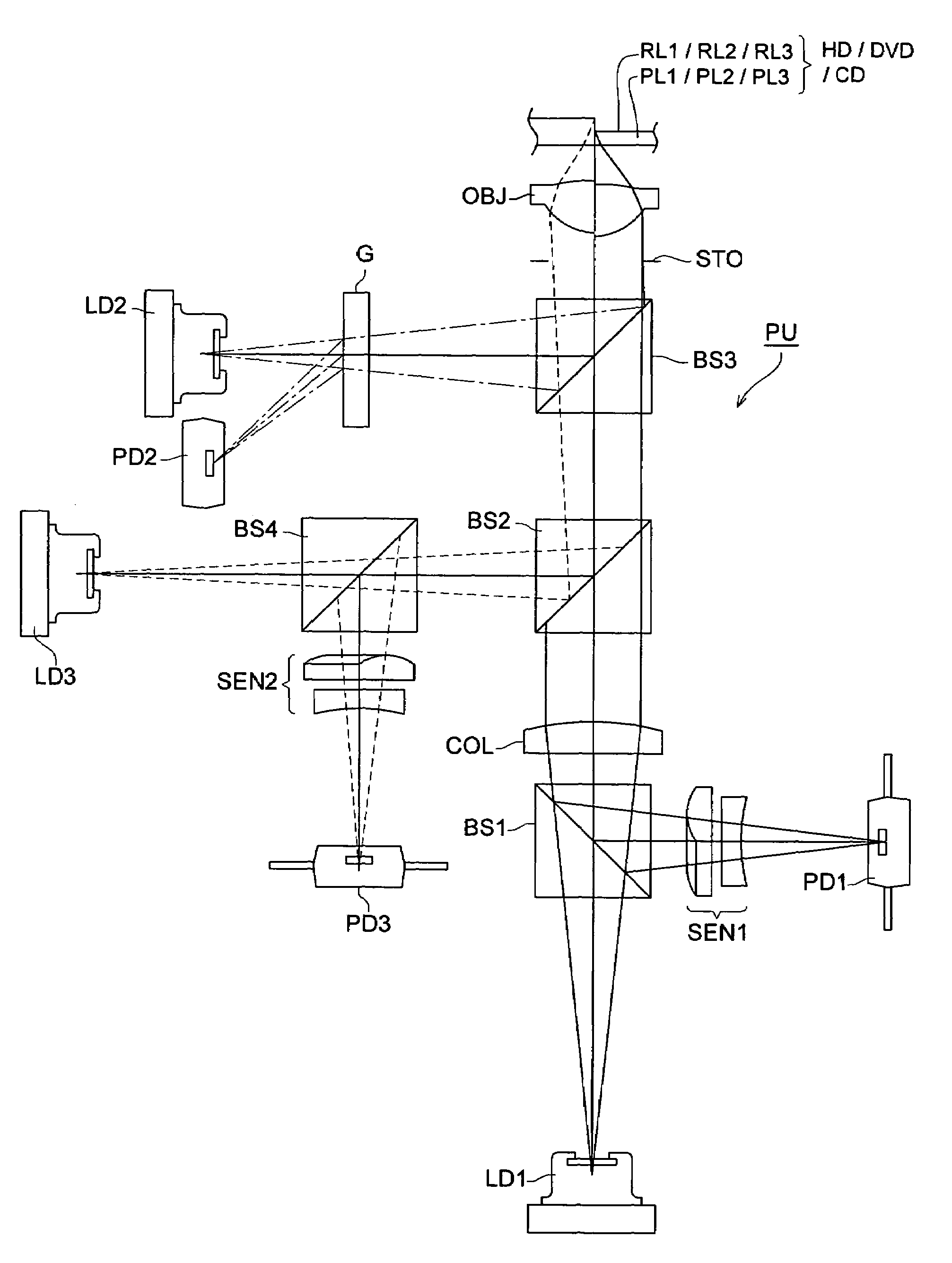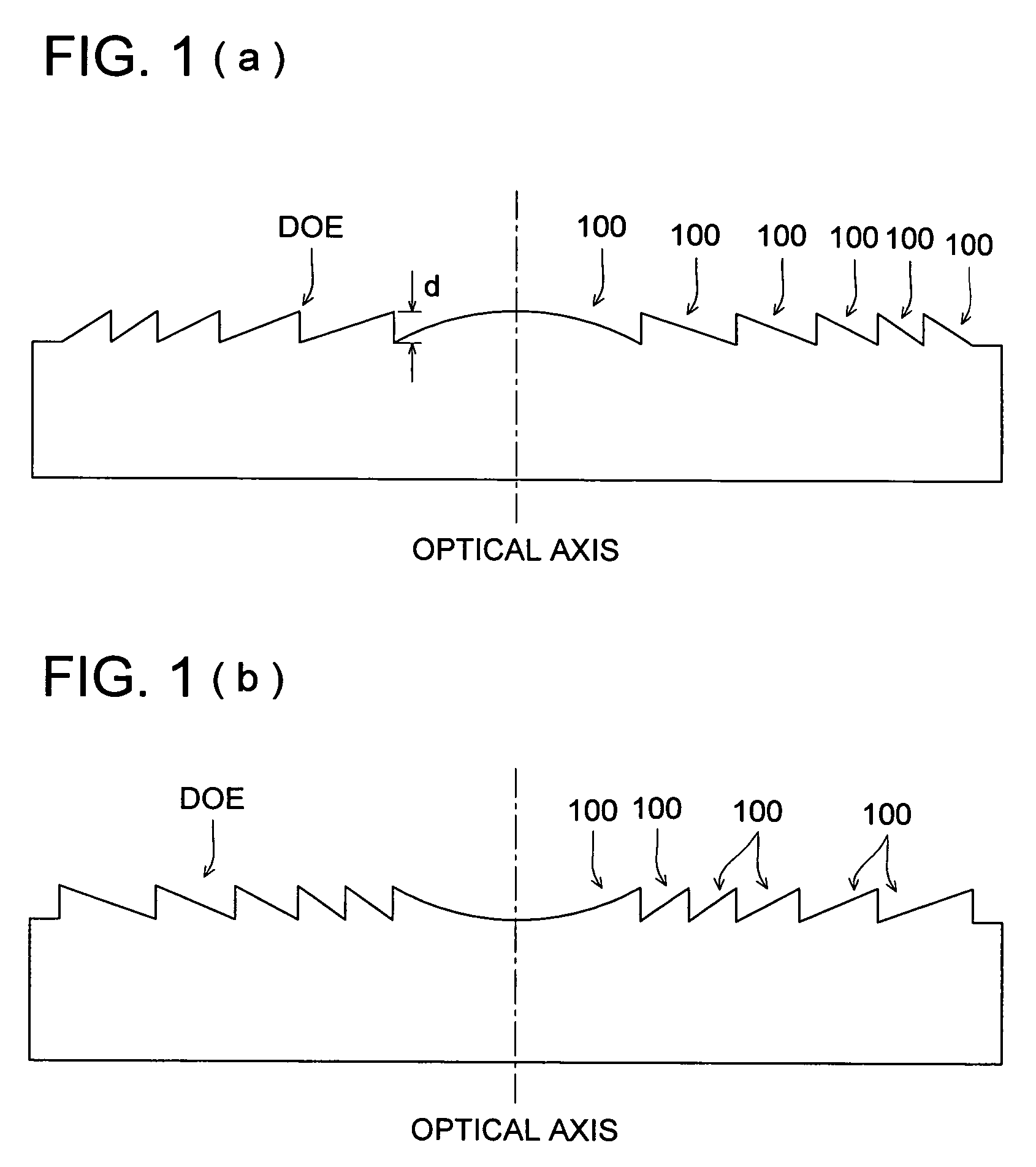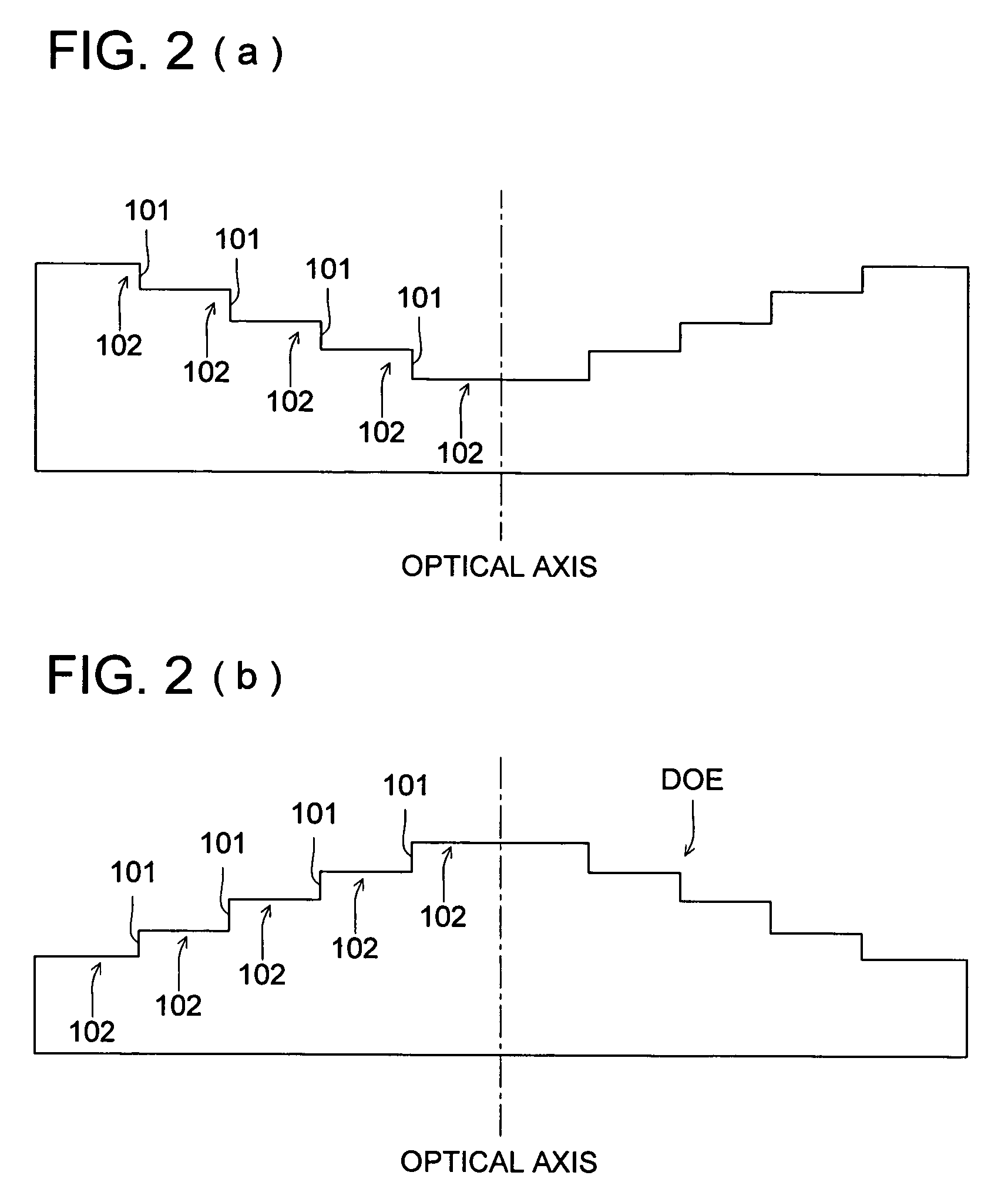Objective lens and optical pickup apparatus for reproducing and/or recording information for at least two types of optical discs
a pickup apparatus and optical disc technology, applied in the field of objective lenses and optical pickup apparatuses, can solve the problems of deterioration of wavefront aberration and increase of wavelength characteristics caused by diffraction, and achieve excellent wavelength characteristics and high density
- Summary
- Abstract
- Description
- Claims
- Application Information
AI Technical Summary
Benefits of technology
Problems solved by technology
Method used
Image
Examples
example 1
[0123]Table 1 shown lens data of Example 1.
[0124]
TABLE 1Example 1 Lens dataFocal length of objectivef1 = 3.2 mmf2 = 3.27 mmf3 = 3.27 mmlensNumerical aperture on theNA1: 0.65NA2: 0.65NA3: 0.51image sideDiffraction order number onn1: 3n2: 2n3: 22nd surfaceMagnificationm1: 0m2: 1 / 185.2m3: −1 / 55.6ithdinidinidinisurfaceri(407 nm)(407 nm)(655 nm)(655 nm)(785 nm)(785 nm)0∞−600.00185.001 *1∞0.10.10.1(φ4.16 mm)(φ4.23 mm)(φ3.40 mm)22.021081.900001.5427711.900001.529151.900001.525413−9.548461.751.01.781.01.481.04∞0.61.618690.61.577521.21.570635∞*1: (Aperture diameter)* The symbol di shows displacement from ith surface to (i + 1)th surface.Aspheric surface dataSecond surfaceAspheric surface coefficientκ−4.4201 × E−1A4−6.6218 × E−4A6−1.4866 × E−3A8+5.2339 × E−4A10−1.0140 × E−4A12+8.5260 × E−6A14−1.1279 × E−6Optical path difference functionB2−2.5983B4−2.8209 × E−1B6−2.7379 × E−1B8+5.2628 × E−2B10−5.2204 × E−3Third surfaceAspheric surface coefficientκ−1.7944 × E+2A4−9.8565 × E−3A6+1.1687 × E−2A8−5...
example 2
[0133]Table 2 shows lens data of Example 2.
[0134]
TABLE 2Example 2 Lens dataFocal length of objectivef1 = 3.2 mmf2 = 3.27 mmf3 = 3.27 mmlensNumerical aperture on theNA1: 0.65NA2: 0.65NA3: 0.51image sideDiffraction order numbern1: 3n2: 2n3: 2on 2nd surfaceMagnificationm1: −1 / 185.2m2: 0m3: −1 / 44.8ithdinidinidinisurfaceri(407 nm)(407 nm)(655 nm)(655 nm)(785 nm)(785 nm)0600.00∞130.001 *1∞0.10.10.1(φ4.18 mm)(φ4.25 mm)(φ3.41 mm)22.024501.900001.5427711.900001.529151.900001.525413−9.521531.761.01.801.01.501.04∞0.61.618690.61.577521.21.570635∞*1: (Aperture diameter)* The symbol di shows displacement from ith surface to (i + 1)th surface.Aspheric surface dataSecond surfaceAspheric surface coefficientκ−4.4431 × E−1A4−9.1275 × E−4A6−1.4646 × E−3A8+5.2560 × E−4A10−1.0309 × E−4A12+8.1328 × E−6A14−9.6245 × E−7Optical path difference functionB2−2.7376B4−2.9254 × E−1B6−2.7583 × E−1B8+5.3981 × E−2B10−5.3153 × E−3Third surfaceAspheric surface coefficientκ−1.7044 × E+2A4−1.0136 × E−2A6+1.1696 × E−2A8−5...
example 3
[0140]Table 3 shows lens data of Example 3.
[0141]
TABLE 3Example 3 Lens dataFocal length of objectivef1 = 3.1 mmf2 = 3.23 mmf3 = 3.23 mmlensNumerical aperture on theNA1: 0.65NA2: 0.65NA3: 0.51image sideOptical systemm1 = 1 / 28.4m2 = 0m3 = −1 / 35.6magnificationithdinidinidinisurfaceri(407 nm)(407 nm)(655 nm)(655 nm)(785 nm)(785 nm)0−85∞117.841 *1∞0.10.10.0(φ5.10 mm)(φ5.10 mm)(φ5.10 mm)21.97491.761.55981.761.54071.761.53722′1.9549−0.003181.5598−0.003181.5407−0.003181.53723−16.87661.571.01.791.01.491.04∞0.61.6190.61.5781.21.5715∞*1: (Aperture diameter)* The symbol di shows a displacement from ith surface to (i + 1)th surface.Aspheric surface dataSecond surface (0.00 mm ≦ h ≦ 1.923 mm)Aspheric surface coefficientκ−5.3412E−01A4−3.6678E−04A6 9.6666E−04A8−1.3357E−04A10−6.7434E−05A12 2.5231E−05A14−3.3947E−06Optical path difference function (HD DVD: Second orderDVD: First order CD: First order Blaze wavelength395 nm)B2−4.1750E−03B4−7.7289E−04B6 2.6030E−04B8−1.1363E−04B10 1.3297E−052′th surf...
PUM
| Property | Measurement | Unit |
|---|---|---|
| wavelength | aaaaa | aaaaa |
| wavelength | aaaaa | aaaaa |
| focal length f1 | aaaaa | aaaaa |
Abstract
Description
Claims
Application Information
 Login to View More
Login to View More - Generate Ideas
- Intellectual Property
- Life Sciences
- Materials
- Tech Scout
- Unparalleled Data Quality
- Higher Quality Content
- 60% Fewer Hallucinations
Browse by: Latest US Patents, China's latest patents, Technical Efficacy Thesaurus, Application Domain, Technology Topic, Popular Technical Reports.
© 2025 PatSnap. All rights reserved.Legal|Privacy policy|Modern Slavery Act Transparency Statement|Sitemap|About US| Contact US: help@patsnap.com



